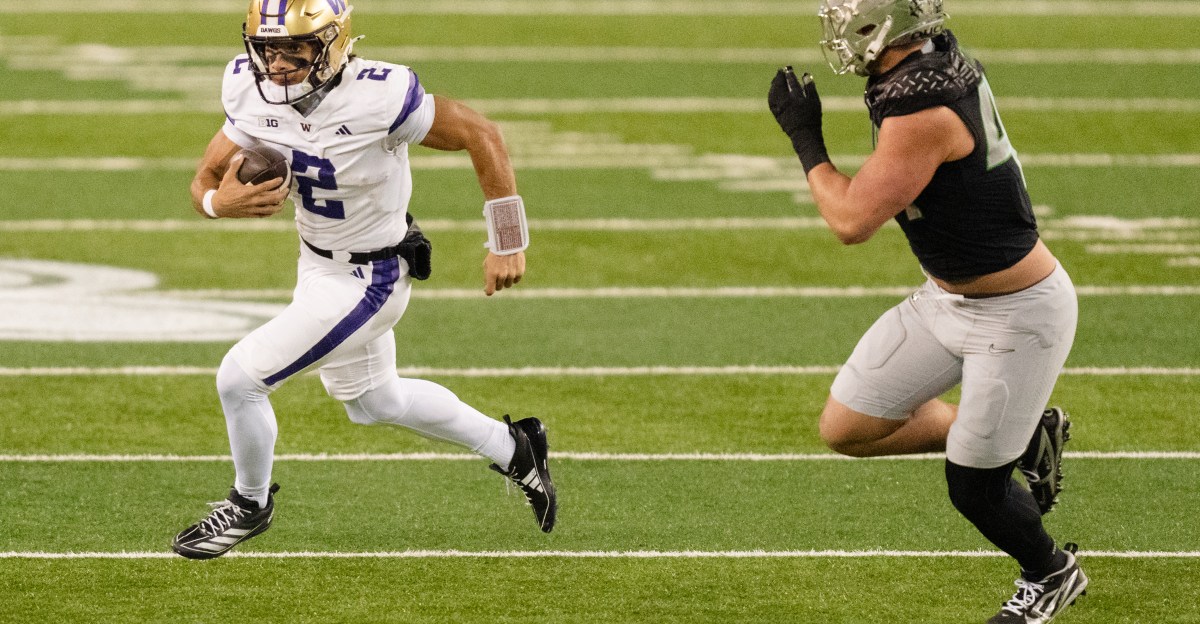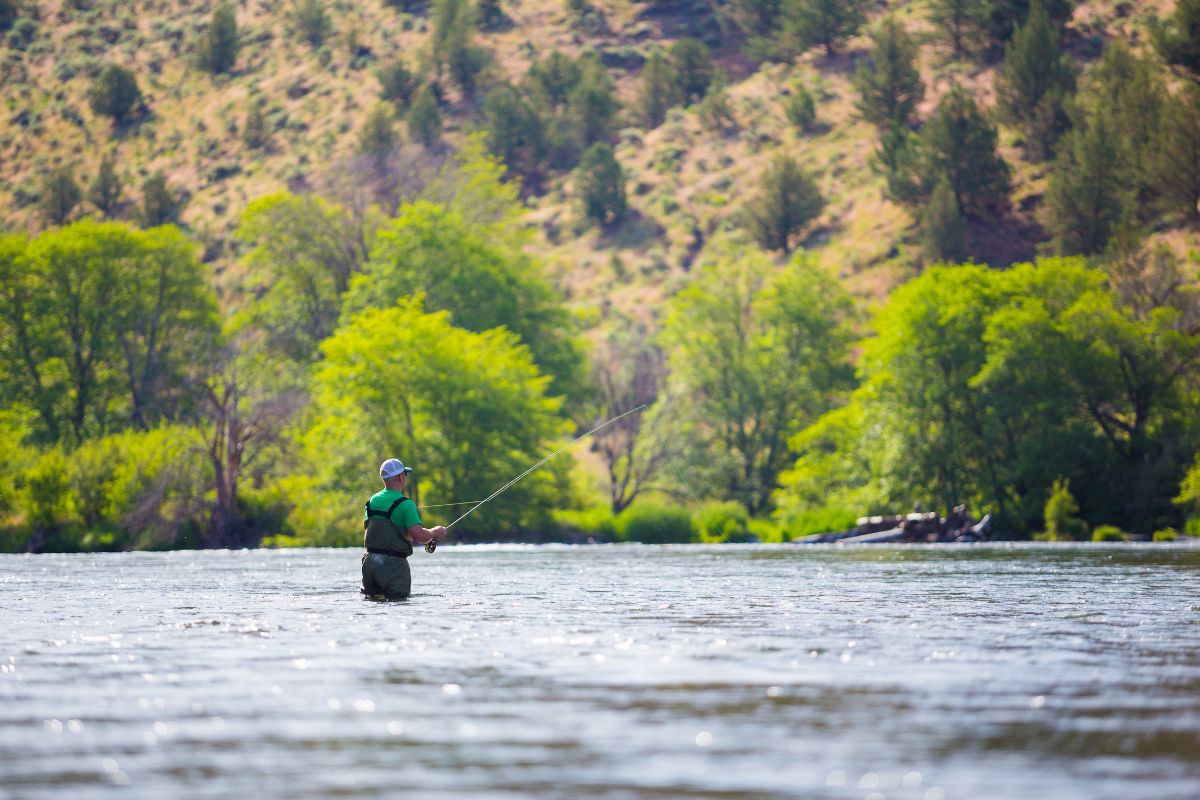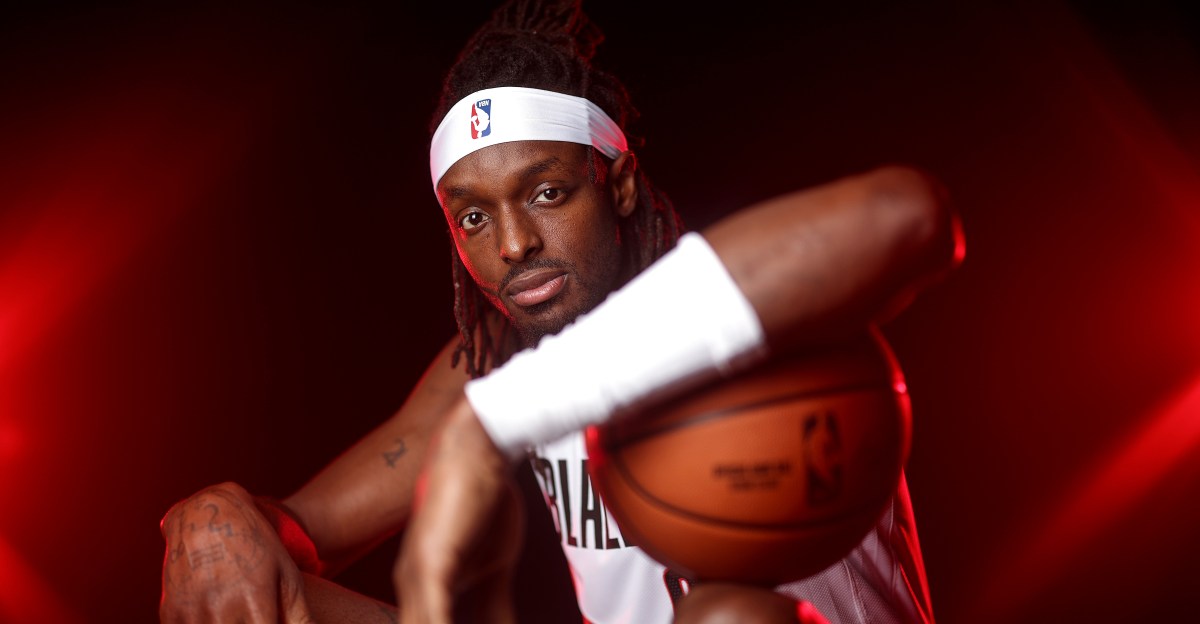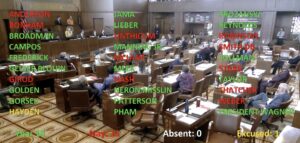Duck Dive: Washington Huskies Football 2025 Preview
Special thanks to Roman Tomashoff of Locked on Huskies for discussing Washington’s roster with me on this week’s podcast:
Nota bene: Since Oregon and Washington played the last week of the season, last Fall’s preview prior to that game and Tristan’s film study of the game itself serve as an effective recap of the Huskies’ 2024 season, their Big Ten debut, and Coach Fisch’s first year in Seattle. The bowl game afterwards provided some potentially useful data on the quarterback position and playcalling shift going into 2025 which will be discussed in this article, but rather than repeat what is almost entirely unchanged analysis of UW’s performance and roster dynamics for last season I would direct the reader to review those articles.
As anticipated, Coach Fisch got a jumpstart with his quarterback of the future by playing #2 QB D. Williams as a true freshman throughout the season, with at least a handful of meaningful snaps in every game as well as starting the final two. On the podcast, Roman and I discussed the challenges with making projections from the data we can gather from Williams’ tape in 2024, because not only are there several reasons to believe those data are distorted by a variety of circumstances, many of those distortions are interlocking and drive each other.
So for example, Williams has an outstanding raw passer rating, but it falls considerably on garbage time adjustment; it’s driven by a spectacularly high completion percentage, but that in turn is driven by a very high ratio of screen passes and a failure to throw the ball away and taking too many sacks. If these things resulted from Williams being given a simplified playbook as a true freshman and excessive pocket breakdowns from one of the worst offensive lines in the league — two things that neither Roman nor I believe will obtain in 2025 — then that whole chain of extreme positives and negatives which could be said about the young QB might be thrown out, or at least taken with a very large grain of salt.
Here are the breakdowns in passing performance between Williams and the starting QB for most of the year, senior transfer Will Rogers, with the full season’s data:
The two biggest drivers in their performance differences are first, Rogers was about twice as likely to throw interceptions as Williams (if Rogers’ INT per dropback rate were FBS nominal his passer rating would be well above average), and second, Williams was clearly given a different playbook to work with which emphasized shorter passes, the read-option game, and rollouts into scrambles. Because screen passes were by far UW’s most efficient weapon in 2024 and Williams threw these at double the rate that Rogers did, he drove up his YPA but drove his explosive rate down. This chart illustrates how Rogers’ distribution was essentially within FBS norms but Williams played a much shorter game:
While Williams will no doubt be given the full playbook from the get-go in 2025 and his distribution will probably normalize, this chart also shows two other phenomena which are more uncertain if they’ll continue or if he’ll grow out of them. One of them is that Williams’ incompletion rate is well below average, or in other words, completing 78% of his passes outside of garbage time – that’s an extraordinary number. But since more than 20% of his pass attempts were screens (about 15% if limited to the two games he started and the second half against Penn State, which was all garbage time but the playbook he operated was much more akin to those starts than the alternative stuff he was doing in the other ten games … I excluded the Penn State garbage time data from statistical computation, naturally, but charted it for mapping out Williams’ playbook) which are much easier to complete, that’s probably an artificial inflation which will likely come down.
More problematically, Williams was clearly holding the ball too long during multiple pocket collapses and taking sacks, or dropping his eyes and scrambling for minimal gains instead of finding an outlet or throwing the ball away, which are suboptimal to the bottom line but also artificially inflate completion percentage. While the global rate of pocket breakdowns per dropback for UW in 2024 was 36.8% (the second worst in the conference behind UCLA, though there’s some stiff competition at the bottom with Maryland, Northwestern, and Purdue), Rogers only wound up taking about 8% of his dropbacks as sacks as he would fairly reliably get rid of the ball into the bleachers or to a dumpoff outlet despite being the far less mobile QB. Williams however took about 20.5% of his dropbacks as sacks, one of the highest rates I’ve seen in years (it’s 15.8% if the Oregon game is excluded, so the very high number of sacks in that game pulled up his average but it was still about double that of Rogers otherwise).
From watching tape, I saw what I’ve come to call the athlete’s paradox – if he gets back across the line of scrimmage he’s an effective enough scrambler (57.1% success rate) that I think he’s convinced himself he’s always going to be able to bail out and salvage the play, and is in the rude process of finding out this isn’t so. As Roman and I discussed on the podcast, this is one of those things that’s up in the air for freshmen – some of them learn their lesson and come back as sophomores more mature, and others don’t. I think that Roman’s observation that Fisch was calculated in how he played Williams was accurate and so I should think there’s a plan in place to help him mature, but we’ll just have to wait and see if it works.
The second interesting phenomenon about Williams’ passing data is his intermediate to deep passing rate – while he threw the ball 15+ air yards downfield far less often than Rogers or the typical FBS QB (all but two of Williams’ that gained 10-25 yards were a screen or short outlet pass with the yardage coming after the catch), he was much more effective than those QBs on a per-pass basis at throwing the ball 30+ air yards. When he had a clean pocket and could wind up, he threw a pretty nice looking rainbow with a lot more loft than I was expecting to see from a freshman of his stature and allowed his receivers to run under the ball for big gains and multiple touchdowns.
The caveat here is that we have a major sample size problem – as with any QB these are the rarest of throws, and with Williams the cleanest pockets he got to try them out were against Louisville in the bowl game and so nearly all of such passes we have to examine come from that game. As I mentioned to Roman, the Cardinals’ secondary is just atrocious and frequently busted coverage so receivers were able to make whatever adjustments necessary midflight and unmolested, in a way that makes it tough to tell if the ball was accurate or not because the receiver was so open – this was exactly the problem (against exactly the same team!) that made me tap the brakes on Miller Moss’ six-TD performance in his bowl debut the year prior when writing up USC in last year’s preview, which proved prescient.
The bowl game also provided some interesting data to round out Williams’ season as a runner, and perhaps more importantly, as a threat to keep the ball in the designed run game. During our Fall podcast last year, Roman and I talked about how Williams elevated all the other running backs’ success rates and yards per carry averages compared to when Rogers was in the game because defenses had to account for Williams keeping the ball and so he eliminated defender from the box count. This was a strong enough phenomenon during the regular season that I thought it would carry over into the bowl game.
However, it did not – Louisville effectively shut down UW’s rushing attack, almost as much so as Oregon. I had the statistical regression engine run a correlation analysis against a wider range of variables than my initial testing and the strongest that came back made me bark with laughter when I saw it, because the metatag it keyed on was something of a joke when I’d entered it – “OBT” for Old Big Ten.
UW played six teams which were members of the Big Ten prior to 2024: Indiana, Iowa, Michigan, Northwestern, Penn State, and Rutgers (average F+ defensive ranking: 25th), while four of the remaining six FBS teams on their schedule were in the Pac-12 prior to 2024 plus two more outside the conference (average F+ defensive ranking: 58th). While the Old Big Ten teams played generally better defense, they had one consistent vulnerability — a counterpart to an issue I’ve written about extensively, the inability of Big Ten offenses to rush explosively — they don’t know how to stop read-option runs. So when Williams went in to run those plays against those teams, he improved rushing outcomes dramatically:
But by the same token, the defenses coming from outside the Old Big Ten bubble were evidently not fooled by such plays, and indeed crushed Williams-based runs far more powerfully than those same defenses could stop Rogers-based runs. In effect, putting Williams in and running a modern offense allowed Fisch to pull a fast one on Midwestern rubes, but half their schedule were wise to the trick so the con and mark reversed.
Operationally, Williams ran the option very well – I have very few run-pass read errors in the RPO game and only one in the designed run game, lower than typical even for veterans in this type of system. The likely backup, #15 QB Horton, I charted extensively at Tulane as he was the frequently used backup behind Michael Pratt in recent years and I was watching tape in their option run game for the Green Wave’s starting RB as well as the other RBs for cohort analysis. Horton actually graded out slightly higher than Pratt on my tally sheet in terms of per-read errors, and while he wasn’t quite as efficient of a passer I thought he was competent enough that it didn’t substantially affect the gameplan when he was called on, and I think the same will probably be true in Seattle.
The new staff had three running backs remaining from the 2023 squad, and brought in three new ones from Arizona in 2024. Three-quarters of meaningful carries went to #1 RB Coleman, a continuation of the smart move Fisch made in 2023 when he’d switched up the RB order and put the then-true sophomore ahead of a returning lead back because of superior performance in the analytics running as his own blocker behind a poor offensive line in 2022. Despite getting nearly five times the workload of either of the other two backs in 2024 — senior Cameron Davis who’s transferred out and freshman #24 RB Mohammed who returns — Coleman significantly outpaced them in adjusted YPC with 5.5, compared to 4.1 for Davis and 3.6 for Mohammed.
Each of the backs were underwater in rushing efficiency, an artifact of just how poor the line was run-blocking, but Coleman’s excellent ability to break tackles against most defenses let him consistently bounce off and turn two yard gains into five yard ones, or get to the outside against defenses surprised that they needed to set the edge and as such UW was one of the few Big Ten teams to hit the FBS median in explosive rushing.
Returning Coleman is great news for UW, though I’m not sure how much more new there is to see in his game and what if anything he’ll get besides a bump in his efficiency figures if the line improves. I’m more interested to see if Mohammed’s very poor YPC number as a freshman can rebound if he gets better blocking — he’s not a small back at 6’0” and 215 lbs, so his being brought down early while Coleman wouldn’t was more of a technical matter in terms of contact balance than physical development — and what the other freshman brought over from Arizona, #4 RB J. Washington, can do as a change-of-pace back. Roman told me Washington was dealing with injuries for much of last year which is why I didn’t see him much.
The curious thing to me is just how few bodies are in the room. Arizona used a very large rotation of backs, for different skillsets and for experimentation to see who was the best – indeed, that’s how Fisch found Coleman in the first place. In 2024, there were three bluechips on the roster who got no meaningful carries — Washington, Sam Adams who’s transferred out, and Daniyel Ngata who graduated — and this cycle they’ve taken a couple of mid 3-star freshman to replace the departures. With Washington a smaller back coming off an injury and who doesn’t seem up to speed in pass protection, I wondered if they might go to the bigger of the true freshmen, #29 RB McMahan, if they took an injury here, but Roman demurred. It seems like they’re just betting Coleman is invincible and tireless, Mohammed is definitely going to work out, and backup plans are for the birds.
UW looked to have three tight ends in their rotation in 2024, but #88 TE Q. Moore suffered a season-ending knee injury in the FCS opener. They didn’t call up either of the reserves, #89 TE Crowell who was redshirting as a freshman or #87 TE R. Otton (who hasn’t seen the field or even a Spring game in three seasons and I’m beginning to think never will), so they proceeded with a two-tight end group of senior Keleki Latu as primary pass catcher and then-true freshman #86 TE DeGraaf who mostly blocked but got about one meaningful target a game.
Latu never really moved the needle for me, his blocking grades were pretty average considering his size and his per-target numbers just barely cracked median at 53% success rate and 8.1 adjusted YPT. He’s signed a UDFA with the Bills. DeGraaf I found to be very intriguing, because he was extraordinarily effective on bluff screens and accelerates very well in open space so I’m curious to see if his per-target numbers scale (15.6 YPT is an insane number and would surely come down with more frequent and varied use but it’s definitely eye-catching). Also, as I’ve only half-joked about with Roman a couple of times, I think DeGraaf’s blocking is so bad it’s great for this league – I’ve basically never seen him block without grabbing jersey, but as holding doesn’t exist in the eyes of Big Ten officials this is an asset not a liability.
Moore returns from injury and I saw him playing extensively on the opposite team as DeGraaf in the Spring game, in exclusively 11-personnel formations then. Roman told me, however, that he thinks that Moore will be the primary tight end and they’ll extensively use the 12-personnel formations in 2025 for a greater variety of run calls than in 2024, which surprised me. The 12-pers that we saw last year was only on about a sixth of plays and very rarely (though we saw more during the bowl game) employed both TEs in run blocking, instead it was usually the case that one stayed in to help block as the line badly needed it and the other detached into the pattern. This has been how Fisch has used tight ends — predominantly 11-pers, and 12-pers really only in specialty packages or decoys — since mid-2021 when he adopted the offensive style he’s been using ever since, so Roman suggesting otherwise caught me off-guard.
I think they’d need more depth to pull it off, and I’m not sure where it’d come from. Crowell and Otton didn’t appear in the Spring game with injuries, and both the prep recruits come in undersized. The transfer is #44 TE Eldridge from USC, but he couldn’t run block for the Trojans and friend of the series Alicia de Artola Castillo told me he bounced because he wanted more pass targets, and Roman said Eldridge still has technical matters to work on in run blocking as he’s observed him in Seattle.
UW only had three wideouts in the rotation during meaningful play, though a couple others came in for some garbage time run. The two who got a little under forty percent of the meaningful targets apiece were inside receiver Giles Jackson and outside receiver #12 WR Boston, and the third who got a little over twenty percent was outside receiver Jeremiah Hunter.
Roman instantly noted how odd the passing distribution was, because Hunter was by far the most valuable on a per-target basis: 60.5% success rate and 9.7 adjusted YPT, which made him one of the top efficiency wideouts in the Big Ten. Jackson and Boston had very similar numbers around 50/50 success and good but not great 8.2 adjusted YPT. Hunter has graduated while Jackson has signed a UDFA with the Eagles (I found that to be backwards but the vagaries of NFL selection are beyond me). Keith Reynolds and Jason Robinson transferred out of the unit without really seeing the field.
Boston returns and I think he certainly has the potential to be a more valuable wideout than his 2024 numbers indicated with his huge 6’4” frame and contested-catch ability. I think most of the efficiency issues had to do with how his routes differed from Hunter’s and the inability of Rogers to hit them, o-line blocking problems making for wobbly passes he’d probably be better at locking down if they weren’t the worst in the league, and finally that Fisch tends to call redzone fades with Boston as the predetermined receiver whether he’s covered or not and he’s the victim of a lot of knockdowns which aren’t really his fault (actually I have no idea how that’ll get fixed, though Fisch does have a history of eventually figuring out square pegs don’t fit in round holes).
We spent quite a while on the podcast sorting through the three young returners plus one older returner they’d brought over from Arizona who didn’t get meaningful play in 2024, due to a number of confusing injuries during the Fall — some of which spilled over into the Spring game and made parsing who we saw when unreliable — as well as some indications in my opinion that the staff likes quite a few of the new faces they’ve brought in even more. I’ll spare the reader the full recitation and provide my conclusions after working this through with Roman: the order in the slot is likely to be redshirt sophomore #3 WR R. Williams since he was getting the most garbage time run and Fisch likes them taller in the slot for in-breaking routes over the middle, then true sophomore #13 WR A. Harris for essentially the same reasons, and last #0 WR Green because Fisch has been jerking that guy around for years.
At the X-receiver spot, Boston is essentially never going to come off the field assuming he stays healthy. However, one of the true freshmen, perhaps #8 WR Lawson or #7 WR Vines-Bright, is more likely to back him up in 2025 than the redshirt freshman #16 WR J. Williams even though he’s older and bigger at 6’4” since, reading between the lines, he’s taking his sweet time to get playable. At Z, the starter is likely to be #5 WR O. Evans who transferred from Penn State, exactly what I was worried about for reasons that I explained when writing up that team – he was the fastest guy on that squad but used in a completely gimmicky manner which tanked his efficiency stats and yet he still came through with a pretty high adjusted YPT, and Roman told me his workouts indicated that UW would use him the way his maker intended. Again I think the backup at Z is one of the true freshmen, Lawson or Vines-Bright; the Spring game didn’t give reliable enough data to tease those two apart positionally but I believe I can separate them from the rest of the unit on the outside and ahead of certain returners.
Based on my charting of his college offense of the last three and a half seasons as well as his time on UCLA’s offensive staff, Fisch needs three things out of his pass catchers to effectively run his operation at a high level, of which I’m certain he’s got the first two: a sideline field stretcher and smoke screen receivers. But the critical element to which about 60% of the volume of targets go are ~15-yard in-cuts over the middle, and he’s replacing all three of the primary outlets for these in Hunter, Jackson, and Latu for 2025. Most of Fisch’s skill position roster management test — or in the alternative, his ability to re-invent the offense for the third, arguably fourth time as a college head coach — lies in doing so this offseason.
The Huskies’ offensive line in 2024 was a horrorshow, a situation that was largely inevitable given the way the previous staff had pushed all their chips in on 2023 and then skipped town ahead of the floorman. But it got worse due to two factors: first that their best option at left tackle was Going Through Some Stuff and the two other guys they played at that spot were turnstiles, and second that they made some poor choices on their portal takes and rotations at the guard spots which were unforced but predictable errors, which I know because I predicted them.
The best news for UW’s offense in 2025 is that the most problematic players from the most problematic group are not in a position to trouble them anymore. Two of the least effective linemen I’ve ever seen have left – left tackle Kahlee Tafai has transferred out while guard Enokk Vimahi has graduated (I tried to warn UW fans about Vimahi when he came in from Ohio State, just as I tried to warn Minnesota fans about Tafai this season; like Cassandra my portents of doom are rarely heeded), while center D’Angelo Titialii who I thought was commendable at Portland State but had some trouble at the Power conference level has graduated and appropriately named but inappropriately trained guard Gaard Memmelaar never figured out how to run block over five years and transferred to someplace warmer.
On the other hand, three of the least problematic linemen return: #74 RT Azzopardi who was the only starter to not rotate and will probably simpy continue in his job, #66 C L. Hatchett who’s shown a lot of potential even as a true freshman during their title run in 2023, and #77 OT McCree who was their best left tackle despite dealing with weight changes, family matters, and going in and out of the lineup at multiple schools. In my opinion, none of these three were fantastic, as Azzopardi has a low ceiling, Hatchett was very inconsistent, and McCree will probably be moved to backup RT as he gets his feet under him, but each are a better linemen than the guys who’ve left.
To round out the returners, I think the most significant is the only bluechip of the 2024 cycle, #53 OL Finau, who redshirted last year but played in the bowl game, looks to be at playing size in 2025, and acquitted himself well in the Spring game at LG, which is where Roman and I think he’ll start this Fall. Next most important is #58 C Henning, a 2023 low 3-star who’ll probably be the backup center behind Hatchett. I think that’s it for the returners, as #68 LT Faasolo demonstrated he was unplayable last year, #76 OT Jackett is still maybe 40 lbs underweight for his height and should consider switching to tight end, and the last two are mid 3-star redshirt freshmen with no playing time whom Roman didn’t bother to mention.
There are two transfers and five true freshmen into the room. Roman mentioned the two highest rated 2025 preps as maybes at left and right guard respectively, low 4-stars #72 OG Mills and #73 OG Taulealea. I have a hard time buying it, I think the staff will default to older players over true freshmen, but I watched them both in the Spring game and while they have some technical footwork issues to work on their physical development is ahead of schedule.
I think both the super senior transfers will get starting jobs. Those are #50 OT Willis from Kansas State, the starter at right tackle there for the last two seasons who Roman said would switch to the left side and take over for the three-man snafu (he also relayed an interesting story from Willis about biomechanical chirality), and the center’s older brother #56 OG G. Hatchett who returns to UW after a season abroad at Oklahoma. The older Hatchett won a starting job in Norman but only lasted a single game before getting hurt and hitting the portal back to Seattle to be with his little brother again. To be honest I’m not sure what that means; the Sooners’ once legendary OL coach Bill Bedenbaugh has in my opinion completely lost the plot and for the last four years taken without fail every incompetent Pac-12 lineman from the portal, and the younger Hatchett has always graded out better for me. When Roman suggested that the older brother would start at RG but lose his job to Taulealea I initially scoffed but the more I’ve thought about it the more I can see it happening due to, if the reader follows my meaning, Bedenbaugh’s reverse endorsement.
As we said a couple of times on the podcast, though it bears repeating: there’s nowhere to go but up for this line. The composition in 2025 looks miles ahead of 2024 in stability and reliability simply for the likelihood of minimizing rotations instead of having three guys play left tackle and four guys play musical chairs on the interior, as well as cycling out the ghastliest players for replacement-value ones while retaining the above-board linemen. A line made of Willis-Finau-Hatchett-Hatchett-Azzopardi would be, I think, five basically competent players of whom only one is completely new to Seattle (arguably; the older Hatchett’s return is a complete novelty to my data collection and I’m eager to see how his performance fits in the model) and perhaps the first time since former OL coach Chris Strausser left for the NFL in 2016 that I wouldn’t have a big problem with UW’s o-line composition or coaching.
For all of the roster departures between 2023 and 2024 on the defense, and the adaptations that one-year coordinator Steve Belichick implemented with a constantly shifting 2-4 / 3-4 / 3-3-5 structure, the product the Huskies put on the field was pretty familiar to observers for the last decade or so. They played conservatively in the front and didn’t bring a lot of pressure or do much to stuff the run, kept plays in front of them and generally backed out extra defenders into a sticky zone, invited opponents to march down the field without giving up explosive plays and waited patiently for 3rd and long to get off it.
In the fundamental metrics I track from charting and the situational down & distance analysis, UW’s performance rates are almost indistinguishable in 2024 from every year in the long term trend post-2016 (their local peak). The most significant change seems to be the schedule – compared to Pac-12 offenses, in 2024 they played a slate of weaker quarterbacks who were unable to pick apart their zone coverage and so their YPA allowed improved slightly, and as noted earlier Big Ten offenses’ dirty little secret is that they don’t know how to run the ball for chunk yardage like the rest of college football does.
The program’s pattern of defensive conservatism is why the hiring of DC Walters was so shocking to me. Over the course of 2024, ATQ published half a dozen articles about Walters’ unique, high pressure defense which he first brought to Illinois in 2021, then took with him as head coach to Purdue in 2023. Since the Illini kept his structure after Walters departed, when those two teams played in the last two seasons, Walters’ Boilermakers offenses would score their highest points of those seasons against them since he knew how to beat his own defense, and we needed to break down the film of those games with an explanation of why there was such a wild discrepancy prior to the Ducks playing each of Walters’ former teams. As we joked about on the podcast, since Roman has done his own immersion in this scheme, readers might have gotten a little sick of “Ryan Walters month” at ATQ … yet here we are again.
As those readers will recall, Walters’ scheme is about as opposite as one can imagine from the conservative 2-4-5 the Huskies have almost made their identity for living memory. It’s a three-down front with seven in the box at all times, that is typically two linebackers on-ball in a double eagle, one backer off-ball, and a down safety who has all the responsibilities of an ILB. To pay for the aggressive front posture, the back end is under high strain with fewer personnel – three corners in constant man coverage, two on the outside and one on the inside over the slot, and a single very high safety as the sole backup in case anything gets through who has to calculate the angle perfectly to kill the play.
Walters’ history has been exactly as boom-or-bust as that system appears on paper – when he had future NFL talent throughout the defense as he did at Illinois in 2022, it was one of the most effective defenses I’ve ever seen and finished 3rd in F+ rankings. But when it’s had a talent hole anywhere, it completely falls apart, because there’s no redundancy built into it at all – philosophically, the total opposite of what UW’s approach has usually been where they might let you have a little but lots of guys are available to swarm to the tackle.
Given that we had agreed Belichick implemented the system he did precisely because it was the best way to maximize the win total with the talent deficiencies on the inherited roster, the first thing I wanted to know from Roman was if the UW administration had lost its mind in hiring Walters, or if they’d asked to moderate his scheme as we saw him do somewhat last year. Roman assured me that the Huskies knew what they were getting into and plan to run the unmodified, aggressive Walters defense in 2025 (watching the Spring game I certainly recognized the scheme I was familiar with from Illinois and Purdue, though I can’t confirm the first thing). He said that the talent has cycled up significantly since 2024 and that they’re betting they have the coverage on the back end to make this scheme work, with a major increase in operational depth in the front.
That’s certainly correct about the front – like the offensive line, the depth situation had nowhere to go but up after years of neglect and recruiting misses stretching back over three prior coaching staffs to 2019, following a bumper crop of bluechips in 2018. This is the first cycle in six years in which the Huskies have added instead of lost playable depth throughout the front – and that’s true even considering one front player out for the season with injury and four more I have some doubts about. As Roman said on the podcast, it doesn’t necessarily look like anyone in the front will get the exposure for all-conference accolades, but the ability to rotate, try out different packages, and respond to personnel unavailability is something this or really any defensive scheme will find vital and has been slowly leaking out of the program up until now.
We took quite a while on the podcast getting all exact spots for each player sorted — the fact that there were so many new guys to sort was, in its way, proving the most salient point — with the Spring game giving us some pretty shuffled information about d-line techniques and linebacker spots. Because of the scheme change, I’ll organize additions and departures in broad categories but it should be clear that there are significant net gains in playable depth.
In the group I would label defensive linemen in the 2025 scheme, there are five departures (and in my opinion the Huskies will only miss one or two); those are tackles Jacob Bandes who graduated and Sebastian Valdez who signed a UDFA with the 49ers, the high-motor Voi Tunuufi who could play all over from tackle to end to OLB and I always thought was very valuable for his versatility but the NFL sadly won’t take a tweener, and Maurice Heims and Jayden Wayne who I think would be ends in Walters’ defense had they stuck around but they both transferred out, though only Wayne played and that was just a bit.
The transfers into the d-line group are #77 NT Pepa from Utah, #54 DT A. Thompson from Western Michigan and Iowa before that, and #11 DL T. Uiagalelei (cousin of Oregon’s Matayo) from Arizona. Each of them are seniors with years of starting play under their belts I’ve charted for conference film study as high level producers, and to be blunt are simply superior linemen to the guys who are leaving.
The three returners who were starters or primary rotational players at their positions last year and figure to plug right in to their analogous positions in the new scheme with no further elaboration are #90 DT E. Davis, #41 DE Lynch, and #48 DE Lane.
There are six more d-linemen who return from the 2024 roster but in one way or another 2025 would be the first time we’d really see them make an impact, which is what Roman and I discussed as the other and arguably bigger infusion of playable depth to the line. The first two are #92 DT Butler and #98 DT Khan, both of whom Fisch’s staff brought on to the squad last year and redshirted (Butler as a Juco, Khan as a freshman) and the first time I saw them was in the Spring game with the former at nose and latter at 3-tech, though Roman said during the Fall they’ll probably swap those spots.
Next is #97 NT Sagapolu, who started at Oregon as a offensive linemen, transferred to Miami, then Fisch brought to Seattle and converted to the d-line last year – he played in every game but as expected didn’t have the technique down and wasn’t very productive, since this always takes a year when flipping to the other side of the ball for linemen, so now it’s about time for him to play for real.
Finally there are three guys brought in by the previous staff, twin brothers #95 DT A. Parker and #94 DT J. Parker as well as D2 transfer #5 DE Durfee, who have all missed multiple years of eligibility with every injury imaginable (Roman told me about Durfee getting turf toe in both feet, which I wouldn’t wish on my worst enemy) so I’ve never seen any sustained play out of any of them. But every UW writer swears on a stack of North Face pullovers they’re each the greatest linemen in practices they’ve ever seen and this year they’re all good to go for the Fall and will definitely play … although of the three I only saw A. Parker in the Spring game.
I have found the rule of thirds to be helpful with unknowns in football, so rather than projecting all six of these “new” returners coming online at once I think it’s more reasonable to expect to get two of them to play high in the rotation for their position, two to be serviceable backups at times, and two not to see very much. Even applying this rubric it’s a net addition in playable depth, alongside the proven trio of transfers and the five guys out of the room.
Making positional assessments, they should have at minimum two playable noses in Pepa and Sagapolu, and if they get J. Parker (apparently he’s the bigger of the twins) healthy and/or Khan ready to go as a redshirt freshmen then that’s bonus depth. At the 2i/3-tech defensive tackle spot, again they have at minimum two proven guys in Thompson and Davis, plus Roman said Uiagalelei would play out of this spot as well (I saw him at end in the Spring game and he was usually over a tackle at Arizona, and he’s 20 lbs lighter and built longer, so that surprised me, but perhaps he’ll go back and forth), and just like with the noses, if A. Parker and/or the redshirt Butler work out then that’s a bonus. At end, they already have a proven player in Lynch (he was the only guy who could set the edge at all in last year’s defense) and Lane as a backup, so if Durfee is healthy and/or this is where Uiagalelei plays after all, yet again that’s a bonus.
In other words, they could have absolutely terrible luck such that neither of the redshirts and none of the hospital ward guys are ready to go and they’d still be two deep at all three spots with proven guys plus a seventh proven guy who could swing to multiple spots. That’s major strides in operational depth compared to the last five years at UW. They might actually have a shot at getting up to FBS average at run-stopping for a change.
There are three linebacker positions in Walters’ defense, two of which are pretty standard: an on-ball backer I’ve just been calling the fulltime OLB and a traditional MIKE off-ball. The third, however, flips between on- and off-ball — close to 80% on-ball cumulatively in the four years at Illinois then Purdue I’ve charted his defenses which is why I generally categorize this as a double-eagle front — and is the main way that Walters dials up various pressures (I’m sure Walters has a name for this position but neither Roman and I seem to know it, so during the podcast we referred to this as the “switch” linebacker). As it happens this deployment is nearly identical, other than the pressure calls, to the way that Belichick married his 3-4 to the 2-4 roster he inherited last year so these guys would map on very cleanly to the new scheme if anyone had stuck around … but with one exception the few returners didn’t get much run last year and almost all of the linebacker corps likely to play in 2025 is new to Seattle, so this is somewhat academic.
The departures are extensive from the linebacker unit, and include UW’s only draft pick from last season, Carson Bruener who was their main ILB and taken in the 7th round by the Steelers. Alphonzo Tuputala, who switched between on- and off-ball, has graduated, as did longtime backup and former walk-on ILB Drew Fowler and another former walk-on who played OLB, Jake Jennings. Then-true freshman Khmori House, who seemed to be the plan for the future after all these seniors graduated, got a lot of run on- and off-ball but transferred out, as did backup OLB Lance Holtzclaw, and ILB Byrun Parham who took a redshirt after four games when he couldn’t beat out the incumbents.
The most experienced returner is #91 OLB I. Ward, who came over from Arizona last year where he was already a productive speed rusher, although he’s so light that he’s graded out pretty poorly for me the last two years when setting the edge in run support. We didn’t see a whole lot of meaningful play for any of the others – #99 OLB R. Davis only played in three games, had a surprising three-sack performance against UCLA (though, who didn’t), but Roman told me that he’ll be out for the season with an injury, while #44 OLB H. Moore who came over from Michigan last cycle only saw a couple of garbage time snaps and didn’t play in the Spring game until late. Ward’s older brother #57 LB A. Ward had initially signed with UW as a walk-on, transferred to Arizona, and rejoined UW last year – he played in every game, but didn’t show up during meaningful play on my tally sheet. The first time I saw #17 LB D. Bryant was in the Spring game when he was playing switch, though I thought that was a little odd since he’s not very long and I think under six-foot, so when Roman said he’ll probably just be the backup MIKE that made more sense.
They’ve taken three transfer linebackers, each very experienced starters at their previous school: #10 LB X. Alexander from UCF, #3 LB Al-Uqdah from Wazzu, and #9 LB Manu from Arizona. Roman said that Alexander will get the starting switch job, which makes sense for his dimensions. I’ve charted both Al-Uqdah and Manu and they’re pretty good inside backers, but Roman said Manu is coming off of an ACL tear and his timeline is uncertain (he also said the same is true of a highly rated prep recruit they’re excited about for the future, #23 LB Rainey-Sale), so for the time being the job is Al-Uqdah’s.
I think if it weren’t for the injury news with Davis, Manu, and Rainey-Sale (who might have been good to play early), UW would have been a lot better positioned for linebacker depth. As it is, they should have a competent and experienced starter plus at each position — Al-Uqdah, Alexander, and the younger Ward — which is a good initial setup. But behind them are just one pretty inexperienced backup apiece — Bryant, the older Ward, and Moore, respectively — about whom we know very little and there’s a pretty good chance of a falloff if and when they sub in or could create fatigue issues if the staff elects to forgo rotation.
And if they run into a problem, behind those guys are nothing but true freshmen whom Roman said the staff would prefer to redshirt and walk-ons I saw in the Spring game but have never seen the field during competitve play. The former category comprises Fall-arriving mid 3-stars Devin Hyde and Victor Sanchez Hernandez on-ball and low 4-star #22 LB Epperson off-ball; the latter category is #14 OLB Hopkins on-ball and #49 LB Miller off-ball. I’m not sure how the staff would make choices between them, but as it appears they only have six guys for three spots ahead of them they’d need to go an entire season without further misadventure to avoid it.
On the vast majority of snaps in Walters’ scheme, the box (or “down”, I learned from Roman) safety and high (or “post”) safety play such radically different roles that when I was first charting his teams play I was a bit confused about who I was watching. That’s because in a typical double-eagle configuration with the switch linebacker on-ball opposite the fulltime OLB, the down safety is alongside the MIKE and looking for all the world like a second ILB while the post safety is backed out so far, 25 yards or more from the line of scrimmage, that he wouldn’t even be on camera in the broadcast angle for the duration of a number of plays. But we ran into an issue during the podcast that points up why it still makes sense to discuss both safeties at the same time – the scheme does have them trade off at times by spinning up or down as necessary to deal with offenses going unbalanced or putting a late man into motion, and during the Spring game evidently many of the guys we watched were playing a good deal of snaps spun to a different spot than they were during the rest of practices.
There’s only one returner with significant experience here, #24 DB Esteen. The covid super-senior had traded off time with FCS transfer Cameron Broussard last year in their multiple safety look. They’ve also lost longtime starting free safety Kamren Fabiculanen (I think he’d have been perfect for the post in this defense), while Indiana transfer Jordan Shaw who was the starting nickel in the previous scheme but wouldn’t have really fit this one has transferred back out. Three backups have all transferred out as well: Tristan Dunn, Justin Harrington, and Peyton Waters.
Roman told me that Esteen will be the starting post safety and FIU transfer #4 DB Christian will be the starting down safety. I’m not sure what to think of that configuration; it’s a novel role for Esteen who’s never been that isolated before, and I haven’t seen Christian’s tape and can’t figure out why a multiple-year starter with 150 career tackles doesn’t have higher than a .86 transfer value attached. We’ll have to wait and see how they perform in the new defense.
I was a bit surprised by Roman’s rundown of the backup safety situation. The program had to go nine rounds to retain bluechip sophomore #27 DB Holmes, who got the most backup run of any safety last year, but Roman said the staff was considering a position switch for him and he’s maybe in third place for the post spot. I thought #12 DB McLaughlin, who’d won a mess of FCS awards as an incredibly productive safety (and UW isn’t afraid of playing FCS guys, a half-dozen former FCS players are on this year or last-year’s two-deep) looked great in the Spring game and Roman said he loved his tape, but he also said he’s not going to beat out Esteen for a job which I had kind of figured he would. Instead Roman told me the program is putting its money on true freshman bluechip #18 DB Dillard-Allen who he expects to play in every game.
I don’t know what to make of any of this. Roman’s predictions have been spot-on and I have no reason to doubt this is the way the Huskies will start the year, but I wouldn’t be surprised if there’s some midseason re-evaluation with some more tape given that there’s only one guy who’s played at the Power level and none in a defense like this before. Walters’ scheme puts a lot of pressure on the backfield and going into the year without a large group of experienced, highly rated talents would make me nervous.
At the two outside corner spots, the Huskies last year picked up the 6’4” starter #7 CB Prysock from Arizona to go with the holdovers Thaddeus Dixon and Elijah Jackson from the 2023 title run. Meanwhile Oregon transfer Darren Barkins and redshirt freshmen blueships Caleb Presley and Curley Reed continued to ride the bench, redshirt freshman #0 CB L. Bryant got some garbage time play, and a trio of 3-star recruits in #20 CB Clark, #26 CB E. Johnson, and #15 CB Wright redshirted. In my opinion Prysock’s 2024 in Seattle was a disappointment compared to his 2023 in Tucson, having charted both, though I’m not really sure what contributed to that (Roman suggested some unreported injuries affected him, but I don’t know why the staff wouldn’t have rested him given that they had the depth to do so), while Dixon and Jackson were just as mediocre as every year I’ve watched them.
Prysock returns for another go of it in 2025, and is joined by another 6’4” Arizona transfer who had a great 2023 but not a great 2024 in #8 CB T. Davis. Dixon, Jackson, Barkins, Presley, and Reed all transferred out, I supposed having seen the writing on the wall. Roman told me that Bryant should be one of the outside corner backups and that he had a nice Spring in practices, though he’s sort of the odd man out in terms of body type at six-foot-even. His next freshman surprise for me was the other outside corner backup, who he insisted would be mid 4-star Dylan Robinson when he enrolls in the Fall, and told a story about seeing Robinson standing between Prysock and Davis during a visit and not being able to tell any of their builds apart.
At the inside corner position, which is perhaps the highest of all the high-stress positions in Walters’ defense as it’s a man coverage position with by definition no safety help against the shiftiest receivers, was where Roman had the most surprises for me – it came down to two guys since the third option in Wright has been hurt, with one of them being the senior safety convert #21 DB McCutcheon and the other being Clark, the redshirt freshman who’d never seen the field. Roman told me the freshman had the senior completely beat out and was hailed as the hero of the offseason, MVP of Spring practice, and ready to lead the defense as a bluechip product of Seattle’s Garfield high … always interesting to see a King County All-Star.
Share this content:




















Post Comment